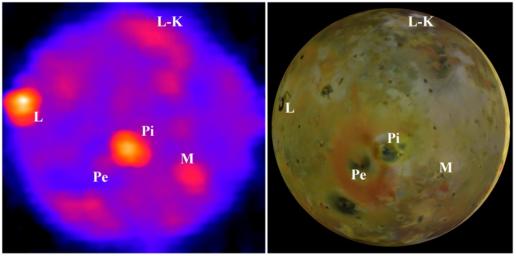Powerful volcanoes and the previous day's sunshine warm the nighttime surface of Jupiter's moon Io, as seen in this image from NASA's Galileo spacecraft.
The left-hand frame shows the best view that Galileo has yet provided of Io's nighttime temperatures. For reference, the right hand frame, based on Galileo camera images, shows the same hemisphere of Io in visible light. The thin bright crescent indicates the only observable portion illuminated by sunlight during the temperature measurements. Several volcanoes are identified on both images: L-K is Lei-Kung Fluctus, L is Loki, Pi is Pillan, M is Marduk, and Pe is Pele.
The temperature map comes from observations by Galileo's photopolarimeter-radiometer instrument during the spacecraft's 27th orbit of Jupiter, in February 2000. Blue indicates the coldest temperatures, near 90 degrees Kelvin (minus 297 degrees Fahrenheit), while oranges and yellows indicate the highest temperatures, in excess of 170 K (minus 153 F). Small areas of the volcanoes are far hotter than this, exceeding 1,500 K (2,240 F). However, in this relatively low-resolution view, which shows no features smaller than about 340 kilometers (210 miles) across, radiation from these small, hot regions is mixed with radiation from surrounding colder regions, so the high temperatures are not detected directly. The observation was made without a filter, so it measures the total heat radiation from Io's night side at all wavelengths.
Much of the heat comes from a few discrete volcanoes. The brightest is Loki, which radiates roughly 15 percent of Io's total volcanic heat, and would appear much brighter still were it not for severe foreshortening due to its position near the edge of the disk. Second brightest is Pillan, where the heat is radiated by extensive cooling lava flows produced largely by an eruption witnessed by Galileo in June 1997 and later. In contrast, although the volcano Pele spouts Io's largest plume, which produces the large orange ring seen in the right-hand image, Pele emits very little total heat. This is because Pele's activity, though vigorous, is confined to a small volcanic crater, where there is no room for large, warm lava flows to radiate heat.
The cooler regions, shown in blues and purples, are dominated by radiation from the surface between the volcanoes, which was warmed by sunlight the previous day and retains some of that heat through the night. Because high-latitude regions receive less sunlight during the day, we would expect them to be cooler at night, but the image shows that temperature varies little with latitude, which is puzzling. Perhaps excess volcanic heat is radiated at the poles, or the polar regions are composed of surface materials that cool off less at night than the materials at lower latitudes. Also, viewing the poles from this angle preferentially presents slopes that were tilted towards the Sun during the day, and thus received more sunlight than the average surface, and this effect might also contribute to the apparent warmth near the poles. The photopolarimeter-radiometer observations of the polar regions on subsequent Io flybys may clear up this mystery.
The Jet Propulsion Laboratory, a division of the California Institute of Technology in Pasadena, manages the Galileo mission for NASA's Office of Space Science, Washington, D.C. Additional information about Galileo and its discoveries is available on the Galileo mission home page at http://solarsystem.nasa.gov/galileo/.

 Planetary Data System
Planetary Data System












